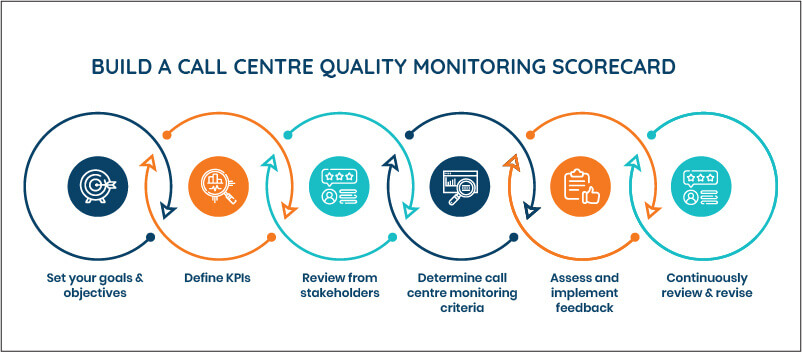How to build an effective call center agent performance scorecard?
Your call center agents are working hard like every other agent. Of course, you have a perception that they are doing a great job handling customer calls and providing delightful customer experiences constantly. Have you tried to deeply understand what did they do well and what needs improvement?
Providing exceptional customer service should be the topmost priority for call centers.
In order to do it, you need your best mechanism to supervise measure, monitor, mentor, and continuously improve your agent’s performance.
What is the correct way to measure the performance of a call center agent?
The key to a good call center performance management system is a great scorecard. A call center agent performance scorecard is meaningful for call center agents, valuable to management, and most importantly, beneficial for customers.
4 Major strategies to improve telecom customer service
What is a call center agent performance scorecard?
It is important for call center agents to keep track of their daily performance and that is, exactly what a scorecard does. The call center agent performance scorecard is not only important for evaluating agent performance but also for taking a closer look at trends to see if any bigger issues need to be addressed. In an effort to evaluate agents’ performance, it is, first, mandatory to decide the list of performance metrics. Now, this is where the concept of a call center agent performance scorecard, can be significant.
You are likely to need a call center agent scorecard template in ‘excel’ to track these metrics. Also, you need to decide which call center performance metrics would you want to track. For example, AHT (Average Handling Time) is a metric that determines how much time your agents are taking to handle a customer’s call. The time that sums from agents picking up the phone to the time, they disconnect the call. There are more of such important metrics that should be included in a call center agent performance scorecard.
The process does not end here. It also includes updating the scorecard at regular intervals. It is completely up to the companies about deciding a timeframe about how often they want to update this scorecard, depending on their business type. Businesses can use tools to update automatically and also share them, with the agents. Businesses need to establish in-house policies to review agent performances regularly. This can also work as a catalyst for businesses to increase their agents’ productivity.
Call center outsourcing services to reshape your customer support
Top 5 call center agent performance metrics
In all center performance management, your decisions impact your business’s bottom line. You need to measure agent productivity. The only way to do it is to have standard and reliable call center KPIs.

Customer Satisfaction (CSAT)
CSAT indicates how your agents performed in solving customer concerns and how satisfied your customer feels. This call center metric can be acquired from several sources. Typically, CSAT scores are collected by conducting customer surveys. While analyzing call center effectiveness and efficiency, CSAT should get topmost priority, irrespective of the method used.
Average Handling Time (AHT)
Average Handling Time is one of the most important call center KPIs to measure agent productivity. As also discussed previously, AHT is the time it takes from when the agent picks up the call until they hang up. AHT is a tricky KPI as it needs to be considered within the range you set up. If your AHT is high, it means you’re struggling to resolve customer queries. If you’re low on AHT, it means, you are not offering proper assistance. Get involved with the team to tackle such business bottlenecks for a seamless experience for your customer.
First Call Resolution (FCR)
FCR is directly related to customer satisfaction. FCR refers to the percentage of calls that a call center representative completely addresses the customers’ concerns without transferring, escalating or calling back. Resolving customers’ concerns on the very first contact determines the customers’ level of satisfaction with your company.
Average Speed of Answer
When you are measuring agent productivity, this is one of the good call center KPIs to look at. The average Speed of Answer calculates the average time it takes for calls to be answered within a specific period. If the KPI is too high, it is possible that your agents aren’t moving as fast as they are assigned to do. In such cases, we suggest you to find a reason to reduce it.
Service Level
Service level is a percentage of calls answered within a specific time in seconds. It measures agent productivity in real time while taking calls. Service level KPI indicates if the customers are getting their resolution on time and whether the business has enough resources to fulfill their needs.
Ready to boost your call center’s efficiency?
How to build an effective call center agent performance scorecard?
Get the combination of KPIs right
With FCR, CSAT, and AHT; you can measure agents’ performances by using a variety of KPIs and suitable call center software. In order to create an effective call center agent performance scorecard, integrating the right metrics is important. Also, be mindful of not making it complex by including too many KPIs. Make the scorecard simple and flexible so it enhances the agent’s productivity levels and they focus on satisfying customers better.
Consider complex customer issues
While building a call center agent performance scorecard, the focus should be on covering complex customer issues handled by an agent. A call center representative deals with a variety of customers coming up with the most complex issues. The duty of an agent is to resolve them, no matter how much time or effort it takes. An effect on the scorecard due to more time-intensive activity should be taken into consideration during measuring their KPIs. Measure your call center agents’ performance both qualitatively and quantitatively by keeping a focus on diverse customer interaction.
Integration of manual and automated scoring methods
You cannot evaluate the call center agent’s performance correctly unless you integrate both manual and automated scoring techniques together. Besides, you must also focus on leveraging the call monitoring and call recording features. The integration of both of these will help you to evaluate individual agent performance and overall call center performance.
Periodically review scorecard KPIs
You need to include several parameters both quantitatively and qualitatively in the scorecard to assess an agent’s performance. There are mainly two types of them, inbound call centers and outbound call centers. Both are very different from each other, in terms of type, nature, and campaigns. It is obvious that you cannot measure both agents’ performance precisely using the same metrics or KPIs. Review and adjust your scorecard KPIs from time to time in order to keep them effective.
Your agents are not bots
These days call centers use customer service bots to automate interactions. While creating a call center agent performance scorecard, be mindful that your customer service agents are not bots. Never judge an agent’s performance only based on a CSAT score. Your agents deal with different customers every day and it is obvious that they cannot make each one of them happy. You should emphasize agents’ efforts, instead of CSAT scores while measuring their performance.
With time, your call center goals are likely to evolve and so will, your agent performance scorecard. Periodically updating and consistent monitoring according to your call center’s latest needs will reflect relevancy on the agent performance scorecard.










